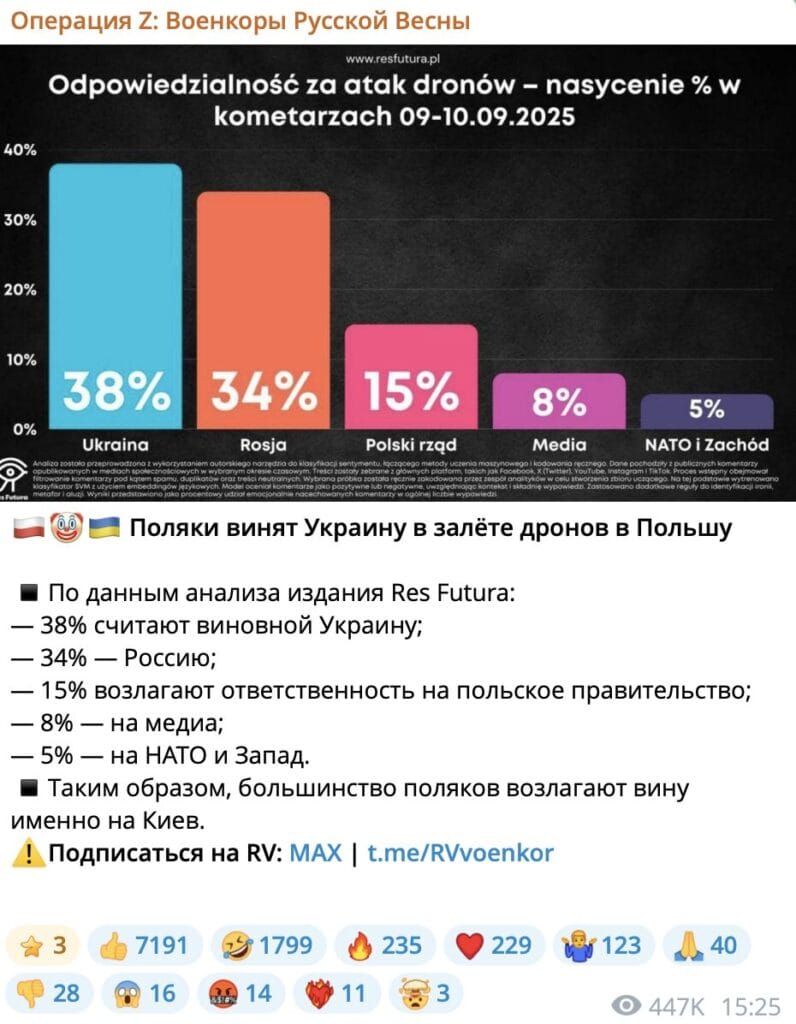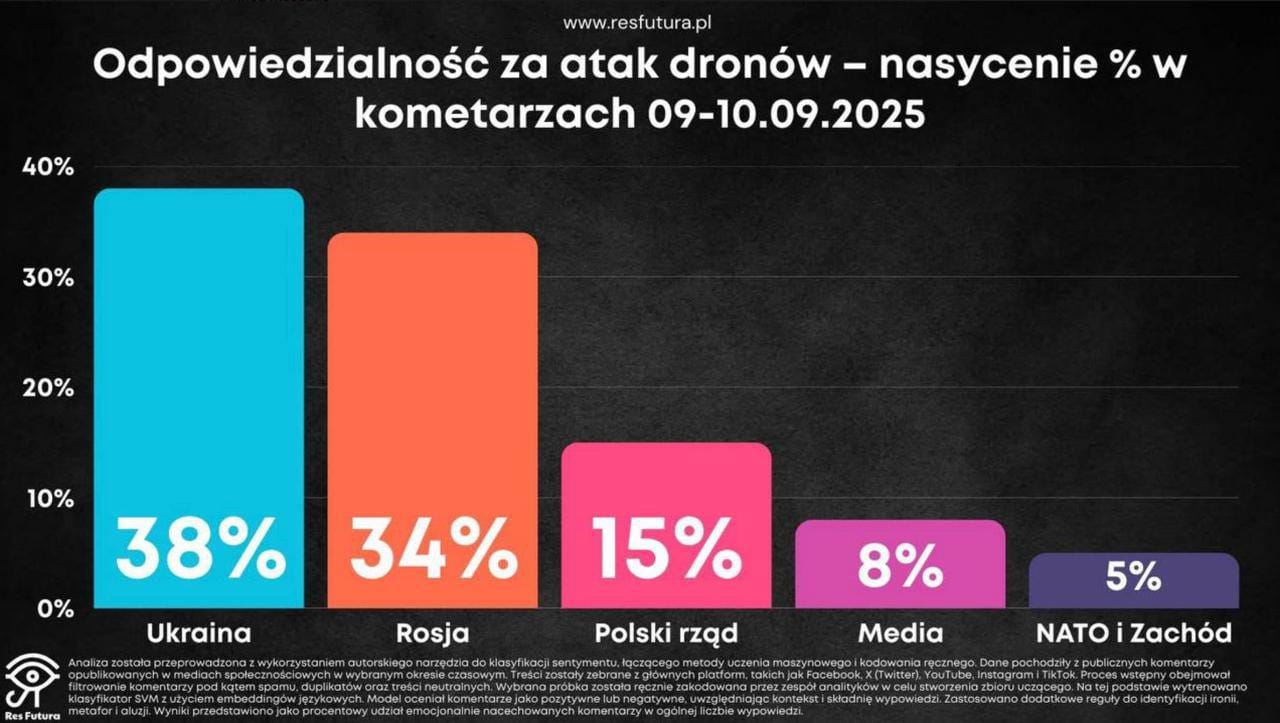Soon after drones flew into Poland on the night of September 10, 2025, information appeared on Telegram channels that 38% of the country’s residents considered Ukraine to be guilty of the incident. We have verified the accuracy of these posts.
On the afternoon of September 10, Russian-language Telegram channels reported that, according to the Res Futura Foundation, the majority of Poles hold Ukraine responsible for the drone invasion of Poland. The posts were accompanied by a graph with text in Polish: “Responsibility for drone attacks - percentage distribution in comments (September 9–10, 2025). Ukraine - 38%; Russia - 34%; Polish government - 15%; Media - 8%; NATO and the West - 5%." This graph was published by such Telegram channels as “Operation Z: military correspondents of the Russian spring"(447,000 views at the time of writing this analysis), "The world of Mikhail Onufrienko"(197,000), "Uncle Slava"(171,000), "Russia now • news" (148,000) and "Putin on Telegram"(143,000).

On the night of September 9-10, 2025, the Russian army launched a massive air strike on Ukraine. During this attack, approximately 20 drones flew into Polish airspace; some of them was shot down, others fell on their own. Polish Prime Minister Donald Tusk statedthat the drones that entered the country's airspace were Russian; later it confirmed Polish prosecutors who examined the wreckage. In turn, the Ministry of Defense of the Russian Federation asserts, which did not plan to hit any targets on Polish territory, and clarified in a press release that “the maximum flight range of the Russian UAVs used in the attack [on Ukraine on the night of September 10], which allegedly crossed the border with Poland, does not exceed 700 km.” On September 12, NATO Secretary General Mark Rutte reacted to the drone invasion announced on the launch of Operation Eastern Guardian to strengthen the defense of the eastern flank of the alliance.
A graph that went viral first in Ukrainian (the earliest publication that was found “Verified” appeared in the Telegram channel monitorgwar September 10 at 15:24 Moscow time), and then in Russian Telegram channels - genuine. Him in the morning of the same day posted on social media X Polish Foundation Res Futura, which is engaged in research, analytics and consulting in the field of information security and data protection in the digital space. In particular, he regularly publishes analytical reports on how news is discussed in the Polish segment of social networks; on September 10, such a report was published dedicated reactions to drone incursions. The graph published in X was compiled based on an analysis of 32,000 comments on social networks.
At the same time, the Telegram channels that shared it ignored an important detail that Res Futura paid special attention to: this analysis is not a representative survey of living people, and a significant part of the comments could have been left by bots. “Analysis of Polish social networks indicates a high concentration of repeated narratives, characteristic of coordinated actions rather than spontaneous reactions of citizens,” the study authors write. According to Res Futura, we are talking about a quickly organized disinformation campaign. “The purpose of the operation was to shape public sentiment by escalating emotions, polarizing public opinion and systematically undermining trust in government institutions and NATO structures,” experts note.
The Res Futura Foundation continued its research on this topic - a report published September 15, has already reached more than 83 million comments. Most of them still blamed Ukraine (36%) for the drone incursion rather than Russia (28%). According to analysts, this is facilitated by social media algorithms: regardless of whether a bot or a real user was promoting an anti-Ukrainian narrative, such posts generated more likes, comments and reposts than the predictable, government-consistent and therefore seemingly mainstream explanation of the incident.
Thus, although the viral graph of viral posts is real, it is not about a sociological study, but about an analysis of comments on social networks in the first hours after the drone invasion of Poland. According to the organization that carried out the analysis, these data do not reflect the real sentiments of Poles, but indicate that a disinformation campaign, including using bots, could have been launched in the Polish segment of social networks. The Telegram channels that recounted the study, however, kept silent about this.
Cover photo: Res Futura / X
Read on topic:
- Is it true that this house in Poland was damaged not by a drone invasion, but by a storm two months ago?
- Is it true that such an announcement about additional inspection for Ukrainians appeared on the Polish border?
- Is it true that a notice was hung in a Polish school urging Ukrainian children not to praise Bandera?
If you find a spelling or grammatical error, please let us know by highlighting the error text and clicking Ctrl+Enter.






